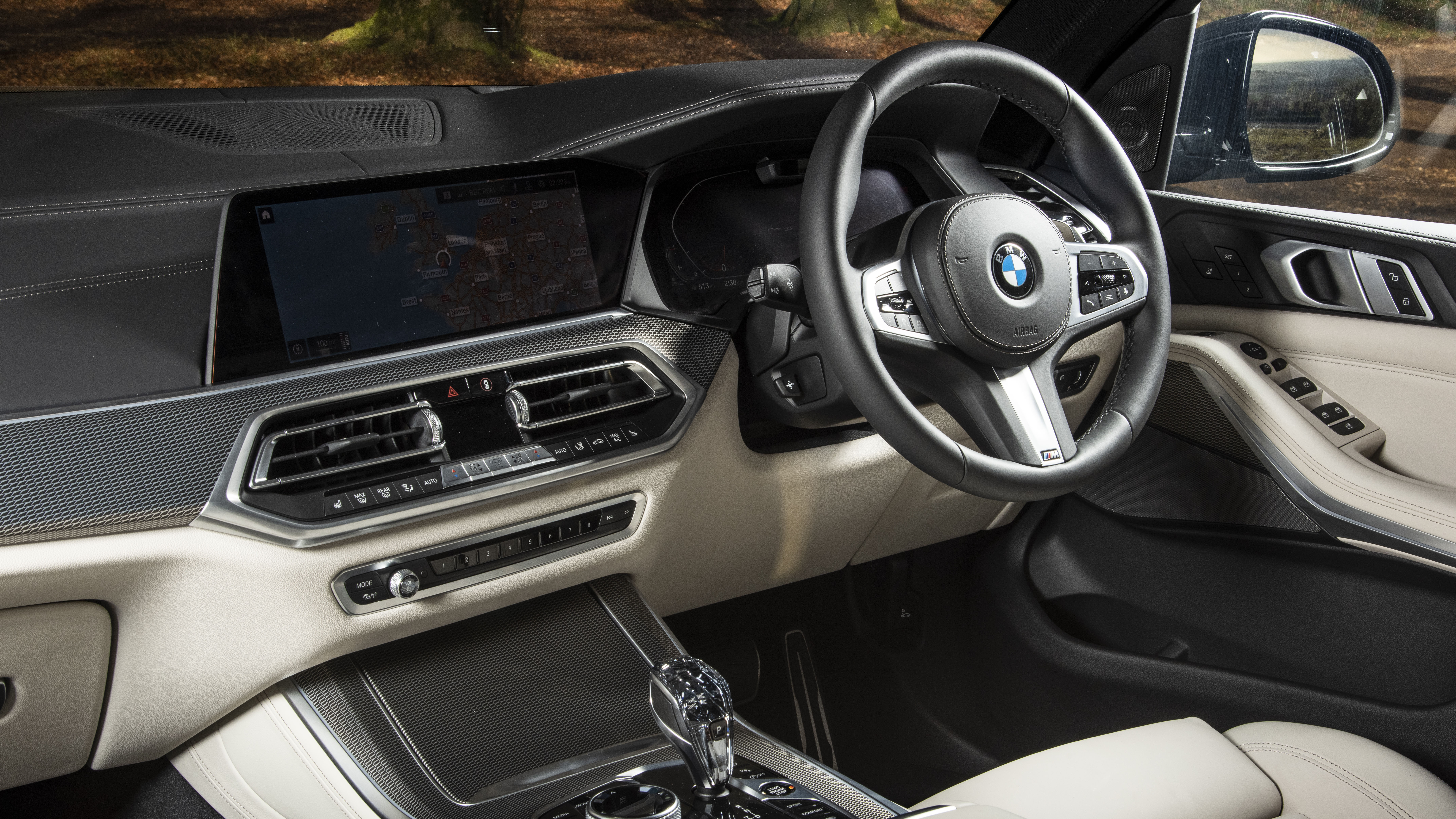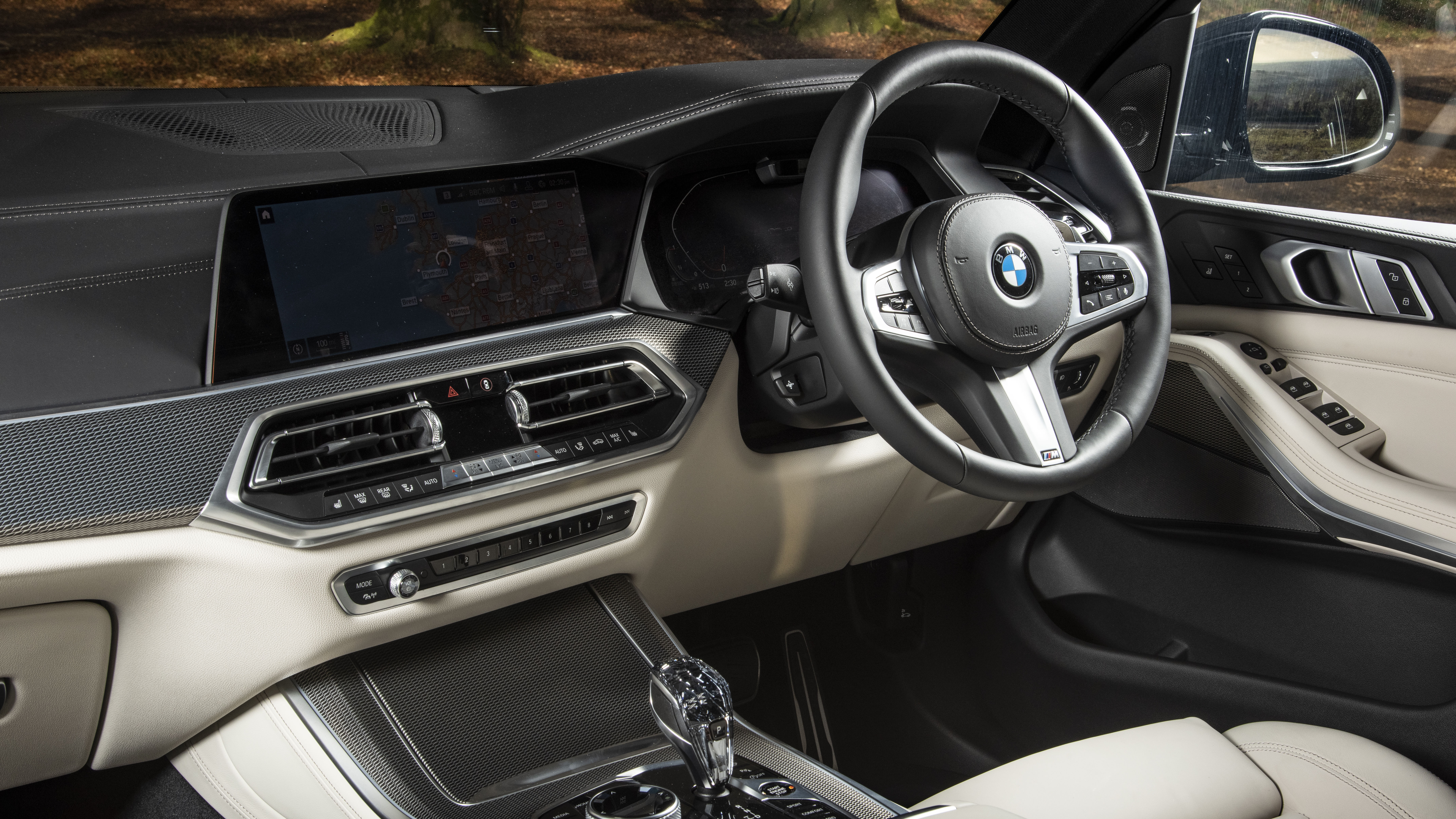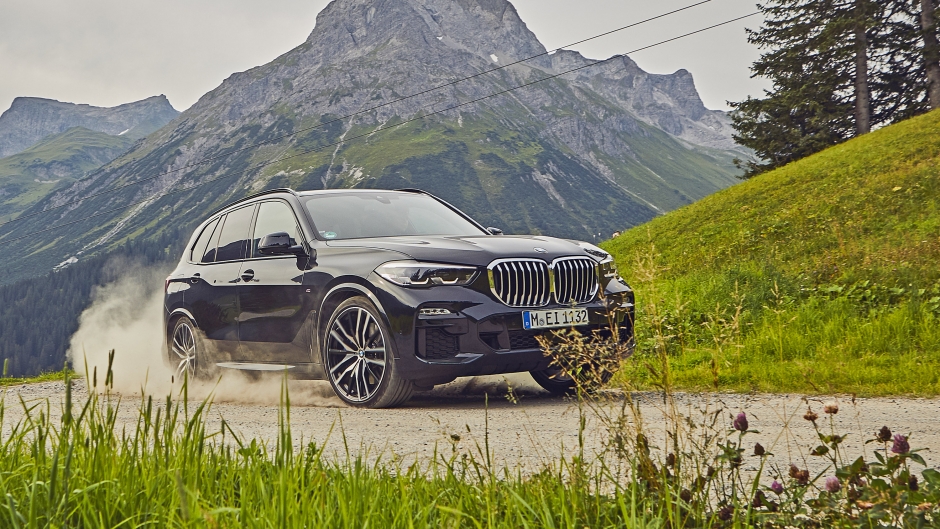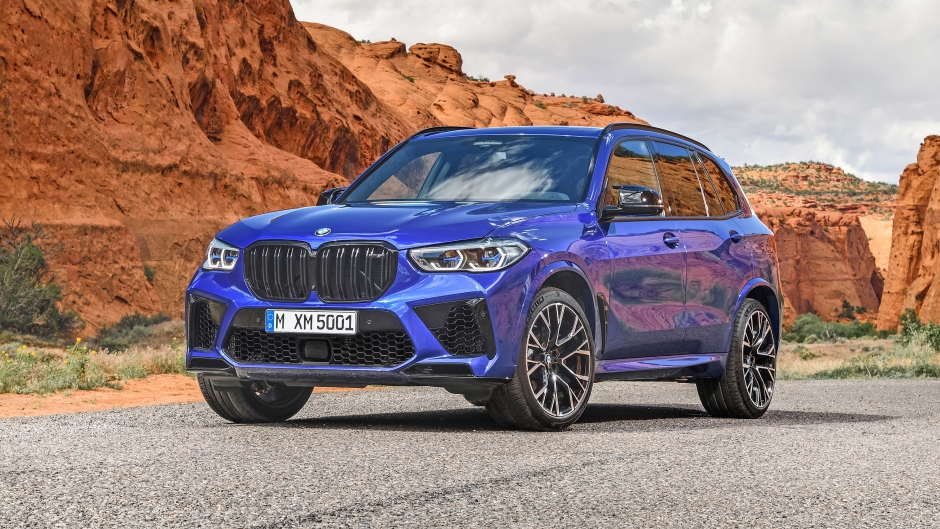BMW X5 Review
As a large, luxurious and fun-to-drive SUV with a great range of engines, the BMW X5 is a car with very broad appeal
Strengths & weaknesses
- Luxurious, high-quality feel
- Efficient, powerful engines
- Substantial levels of equipment
- Some rivals are more spacious
- Seven-seats are not standard
- Range-topping X5 M is very expensive
When the original BMW X5 was launched in 1999 it was a genuine game-changer. Here was an SUV (or '4x4' or 'off-roader' to use the more common terms from the time) that was focused on on-road performance rather than off-roading ability. It was a huge sales success, offering the high driving position and tough looks of a traditional off-roader, but with more comfort and refinement than more off-road-centric vehicles.
Fast forward several decades and the X5 has spawned a whole range of SUVs from BMW in various sizes, plus a raft of rivals, including the Range Rover Sport and Porsche Cayenne. There’s also the Audi Q7 and Mercedes GLE which, like some versions of the X5, come with the added flexibility of seven seats.
Yet the X5 still remains a fine choice if you’re after a large, luxurious and sporty SUV. Despite its substantial size, all models are sufficiently powerful to feel genuinely quick, and standard air suspension (apart from the hugely fast and expensive high-performance X5 M) delivers a comfortable cosseting ride that’s entirely in keeping with the luxury feel of the interior - and means the X5 remains fun to drive, whichever version you go for.
Engine options include a pair of 3.0-litre six-cylinder diesels: the 286hp xDrive30d, which offers claimed fuel economy of 42.2mpg and the xDrive40d model which gets a heftier 340hp for greater acceleration yet can still manage 40.9mpg according to official fuel economy figures.
The low-down punch of the diesel engines make the most sense in a heavy car like the X5, as they’re perfect for heavy loads or for hauling trailers, but the X5 does get the honour of a decent selection of petrol engines, too. The xDrive40i has a 3.0-litre turbocharged six-cylinder petrol engine with 333hp and fuel economy of around 32mpg. There’s also an extremely powerful 530hp eight-cylinder version in the form of the X5 M50i and which can get from 0-62mph in just 4.3 seconds. It does only offer 24.4mpg fuel economy, however, so expect high fuel bills.
Even more expensive and impractical is the X5 M Competition, which delivers a whopping 625hp from its eight-cylinder motor, even greater acceleration and a top speed of 190mph if you select the appropriate option package. It is expensive though - almost twice the price of an entry-level X5. It’s also quite uncomfortable since it doesn’t have the standard car’s air suspension, using more conventional steel springs in the interest of ultimate cornering ability, plus oversized alloy wheels, meaning more metal and less rubber between you and the road.
A much more practical proposition is the xDrive45e plug-in hybrid, which combines a 3.0-litre six-cylinder petrol engine with a powerful electric motor and a battery pack. It’ll travel for up to 54 miles on electric power from a single charge, in fact, without intervention from the petrol engine, with a high official fuel economy figure of 235mpg. Realistically, you won’t achieve anywhere near that if you do any number of long journeys or fail to charge the car regularly, but in everyday driving for most people, it could still prove very efficient.
Inside, the X5 impresses deeply, whichever model you go for. It’s easy to get comfortable thanks to electrically adjustable seats, with a memory function, that provide a broad range of adjustment, and you sit high with a commanding view of the road ahead.
The controls for most of the car’s systems are intuitive and well laid out, and the 12.3-inch central media system can be controlled via touch inputs or by using the physical iDrive rotary controller, which can be easier to use on the move than having to prod a screen. There’s also a configurable digital display instead of traditional dials as standard - which is clear and easy to read.
All models get leather upholstery, heated seats in the front and ambient lighting as standard, plus front collision warning and autonomous emergency braking. When it comes to low-speed manoeuvring, visibility isn’t perfect - particularly to the rear - but there are front, rear and side parking sensors on all models, plus a reversing camera.
Should I get a BMW X5?
✔ Luxurious, high-quality feel
✔ Efficient, powerful engines
✔ Substantial levels of equipment
✘ Some rivals are more spacious
✘ Seven-seats are not standard
✘ Range-topping X5 M is very expensive
If you want a large and luxurious SUV with a sporty feel, there are few better choices than an X5. Its diesel engines are refined, powerful and economical, while the plug-in hybrid model offers an impressively long range on electric power alone.
Some rivals are a little more spacious, and some - like the Porsche Cayenne - are a little more fun to drive, but the X5 offers a balance between practicality, luxury and sportiness that few rivals can genuinely achieve.
Its entertainment and media systems are some of the best around, and the build quality of the well-appointed interior is genuinely superb. The very fastest X5 M is uncomfortably compromised in its quest to achieve supercar speed but other X5 models make superb all-rounders.
- Models explained
- Trim levels
- Engine
- Plug-in hybrid
- Best BMW X5 for...
- Rivals
- Dimensions
- Boot space
- Reliability
- Warranty
- Should I buy used?
- Deals
BMW X5 (2018-present): models explained
BMW X5
The BMW X5 is a large, luxurious SUV with a sporty edge, despite its size. Engine options are universally powerful, while the diesel models add impressive fuel economy to the mix. The car is available with five or seven seats, pitching it both against the sportiest of SUVs such as the Porsche Cayenne and more family-focused holdalls such as the Land Rover Discovery and Volvo XC90.
Its key strengths are its beautifully built, well laid out interior and its ability to be fun to drive that’s only matched by the Porsche Cayenne. Consequently, it should appeal to those after a practical family car, those who fancy a tough-looking SUV and even those who want a large car that still feels sporty to drive.
BMW X5 PHEV
The plug-in hybrid version of the BMW X5 impresses most with its long electric range. Thanks to a 22kWh battery (that’s more than the total battery capacity of some small electric cars), it’s officially capable of running for up to 54 miles on electric power alone from a full charge, before the petrol engine cuts in.
This means that it offers a significantly higher range than the 43 miles you can officially get from the plug-in Volvo XC90, though not as much as the 66 miles that a plug-in hybrid Mercedes GLE is theoretically capable of. That electric power is coupled with a 3.0-litre turbocharged six-cylinder petrol engine that on its own would give the X5 respectably spritely performance.
BMW X5 M Competition
With a 4.4-litre eight-cylinder engine under the bonnet, you’d expect the BMW X5 M Competition to be pretty rapid. And indeed it is. It might be very heavy, weighing in at more than 2,300kg, but with an enormous 625hp available, it can sprint from 0-62mph in 3.8 seconds. For something so hefty, that’s a scarcely believable figure - it's faster than a Porsche 911 supercar.
It isn’t cheap, though. When it comes to new-car prices, the X5 M Competition is an eye-watering £35,000 more than the already rather quick X5 M50i when new.
Which BMW X5 to buy: trim levels

| Trim | Equipment | Deals |
| BMW X5 xLine | Limited stock: xLine trim is the entry point into the X5 range but it’s hardly poorly equipped - you get the full suite of information and entertainment kit, including built-in sat-nav, full leather seats (with the front ones being electrically adjustable and heated), plus an electric tailgate. | |
| BMW X5 M Sport | From £23,200: With the M Sport model you get upgraded suspension, more aggressively sporty styling such as chunky bumpers, 20-inch alloy wheels, gloss-black exterior detailing and a smattering of M Sport logos inside. | |
| BMW X5 M Competiton | Limited stock: With an extraordinary 625hp from its 4.4-litre twin-turbo V8 engine, the big X5 performs like a supercar. Fortunately, with sophisticated suspension that includes electronically adaptive shock absorbers, it very nearly handles like one, too. |
Best BMW X5 engine
With effortless low-down punch and the potential for 40mpg fuel economy, the 3.0-litre diesel engine in the X5 xDrive40d suits the big X5 to a tee. Its substantial 340hp power output makes it capable of accelerating the big SUV from 0-62mph in just 5.5 seconds. That’s hot hatch levels of acceleration.
At the same time, the xDrive40d can muster claimed fuel economy of 40.4mpg, which is barely a whisker less than the 41.5mpg that you can potentially get out of the less powerful xDrive30d version of the same engine. As a result, it offers the best blend of performance, fuel economy and value.
Best BMW X5 plug-in hybrid
The BMW X5 combines a smooth-spinning 3.0-litre six-cylinder 286hp petrol engine with an electric motor that delivers 113hp at its peak. The combined total power output of 394hp is enough to ensure the xDrive45e is every bit as fast as the xDrive40d diesel.
What’s more, the large 22kWh battery pack means that the xDrive 45e has an electric range of up to 54 miles per charge, which is an enormous amount for a plug-in hybrid - rivals such as the Volvo XC90 and Audi Q5 plug-in hybrids will only achieve around half of that.
And even though you’re unlikely to achieve the theoretical 235mpg claimed fuel economy figure in real-world use, the tax advantages that plug-in hybrids are afforded by the government makes the X5 xDrive45e mighty tempting as a company car.
Best BMW X5 model for…

With a range of powerful diesel and petrol engines to choose from, plus a plug-in hybrid with one of the longest electric ranges around, there are plenty of options if you’re in the market for an X5.
| BMW X5 xDrive30d xLine: In entry-level trim the X5 presents excellent value, with heated, electrically adjustable leather seats, an electric tailgate, standard sat-nav and a Wi-Fi hotspot. Meanwhile, the six-cylinder diesel engine in the xDrive30d is the most fuel-efficient X5 (discounting the expensive hybrid model, which should be more efficient if you charge it regularly). | ||
| BMW X5 xDrive45e xLine: Not only will the lower tailpipe emissions in town be perfect for the school run (it emits no harmful tailpipe emission at all when under electric power), but its potential for short hops under electric power, when charged, should also prove easy on the wallet, provided you have a home charger for your X5. | ||
| BMW X5 M50i: Owing to its focus on performance, the M50i gets conventional springs with electronically adjustable shock adbsorbers instead of the air suspension found on most X5 models. It also gets a 530hp eight-cylinder engine, which makes it almost as fast as the full-on X5 M, while being tens of thousands of pounds cheaper. | ||
| BMW X5 M Competition: For some, the sheer power and grip made available to you as a driver will make the X5 M worth it. But for most, it’s simply too compromised and uncomfortable as an everyday family car. It’s also far more expensive than any other X5. |
BMW X5 rivals
With a BMW badge on the bonnet, the X5 is always going to face off against key rivals from Mercedes and Audi. In this case, the Audi Q7 and Mercedes GLE. The Mercedes is a little more comfortable and the Audi a little more classy, but the X5 feels sportier to drive than both of them, while all three feel suitably luxurious.
Another major rival for the X5 is the Volvo XC90. The XC90 feels more elegant and restrained than the BMW, but it’s comparatively expensive in plug-in hybrid form and doesn’t have as great an electric range from a charge. The BMW’s media system easily beats that of the Volvo, too.
For a more sporty driving experience still, you could look to the Porsche Cayenne, the upper versions of which offer performance models every bit as rapid as the supercar-fast X5 M.
BMW X5 practicality: dimensions and boot space

BMW X5 dimensions
The BMW X5 is a big car. It’s 4,922mm long, 2,004mm wide (an even more chunky 2,218mm when you count the extra width needed to accommodate the door mirrors) and 1,745mm tall. That means that you need plenty of space for parking both at home and when out and about - this is not a car that’s easy to thread around narrow multi-storey car parks.
Mind you, that’s also the case with most of the X5’s rivals, although it’s longer than all but the Audi Q7. As a result, think about whether you're happy driving such a large car full stop. If not, a number of smaller SUVs offer the same high-up driving position without being quite as long or wide - such as the BMW X3, Mercedes GLC and Audi Q5 - and one of these might suit you better.
CLICK TO READ OUR FULL STORY ON BMW X5 DIMENSIONS
| Length 4,922mm | Width 2,218mm |
| Height 1,745mm | Weight 2,175kg - 2,510kg |
BMW X5 boot space
The X5 gets a Range Rover-style split tailgate, with the lower half opening downwards and the upper half opening upwards. It’s a neat bit of extra flexibility, as it provides you with an easy way to slide long objects in, or can act as a perch for putting on or taking off muddy boots.
In terms of space, the X5 offers 650 litres of boot room with the rear seats in place, and 1,870 litres with the seats folded down. That drops to 500 litres and 1,720 litres for the plug-in hybrid version, however, as the under-floor space in the boot is taken up by the battery pack. This is also where the third row of seats fold into in seven-seat cars, so the plug-in hybrid xDrive45e is available as a five-seat model only.
CLICK TO READ OUR FULL STORY ON BMW X5 BOOT SPACE
| Seats up 500-650 litres | Seats down 1,720-1,870 litres |
BMW X5 reliability
BMW has struggled with customer satisfaction in recent years, but its overall brand results show some signs of improvement: in 2020 it came 27th out of 30 brands surveyed in the Driver Power customer satisfaction survey, but 2021’s results put it 21st. That’s ahead of Audi, but still behind key rival Mercedes.
The X5 itself, however, fared rather poorly in the 2021 survey, coming in at an unimpressive 70th out of 75 models rated in 2021. Large SUVs are some of the most complex machines on the road, so often the high-tech systems featured in these cars can be more problematic that those in smaller and simpler models.
BMW X5 warranty
A three-year warranty is all you get with the BMW X5, although on the plus side it has no mileage limit. The equivalent warranties from Mercedes and Audi are also three years long, but capped at 60,000 miles.
This means that those who want to get a car that is less than three years old and who cover high mileages could benefit from a greater amount of cover with a BMW X5 than a Mercedes or Audi equivalent. Longer warranties are available with Hyundai and Renault (five years) models or Kia and MG (seven years), for instance, though none of these brands offer a direct rival for the X5.
| 3 years | Unlimited miles |
AVERAGE REPAIR COST PAID BY WARRANTYWISE: £721
CLICK HERE FOR MORE INFORMATION ON USED CAR WARRANTIES
Used BMW X5: should I buy one?

As a desirable model with a premium badge, the BMW X5 isn’t exactly cheap to buy, but as is the case with many desirable SUVs, it holds onto its value pretty well as a used car. The result of this is the X5 often attracts low monthly payments, since finance companies can be confident that an X5 will still be worth a fair amount at the end of a PCP finance contract.
The diesel models in M Sport trim are the most popular as they combine good looks with strong performance and reasonable running costs - and the low-down power of the diesel engines suit a big, heavy SUV, so these are both easier to find second-hand and tend to offer the best monthly payment rates when it comes to used finance.
The plug-in hybrids make an awful lot of sense, too, especially if you have somewhere to charge at home, and many are used as company cars from new, which means examples that are around two or three years old will be relatively easy to find - and are likely to have been well maintained if they’ve been company cars.
Best BMW X5 deals
The plug-in hybrid xDrive45e makes excellent sense if you’re a company car user, as it offers useful tax advantages. It’s also excellent if you have somewhere to cheaply charge the car’s battery at home (public chargers often cost significantly more per kWh than you’ll pay on a domestic tariff), but less useful if you drive long distances regularly or don’t have anywhere to conveniently charge. It’s also available as a five-seater only, whereas as other versions of the X5 are available with seven seats, which may affect whether it works for you.
For high-mileage drivers, the diesel models are the most practical proposition, and the 286hp xDrive30d model will provide more than enough punch and 40mpg-plus fuel economy. This makes it a great value all-rounder for many drivers.
If you’re after a petrol-powered model, the 3.0-litre six-cylinder engine in the xDrive40i model is impressive and could be a good option if you want to avoid diesel models, but the real star of the lineup if you're after very strong performance, is the 530hp M50i. We wouldn't recommend the M50i if you want good fuel economy, though. Its claimed 24.4mpg fuel economy means it'll cost you lots in petrol.
*Representative PCP finance - 2018 Ford Fiesta 1.0 ST-Line Hatchback:
| PCP representative example | APR rates available | |||||
| Cash price £12,000 | APR 7.90% | Value of loan | From | |||
| Fixed monthly payment £218.12 | Annual mileage of 8,000pa | £25,000+ | 6.9% | |||
| Total cost of credit £2,755.55 | Term 48 months | £12,000-£24,999 | 7.9% | |||
| Optional final payment £4,285.79 | Loan value £12,000 | £8,000-£11,999 | 8.9% | |||
| Total amount payable £14,755.55 | Deposit £0 | <8,000 | 9.9% |
BuyaCar is a credit broker, not a lender. Our rates start from 6.9% APR. The rate you are offered will depend on your individual circumstances.
Other Editions
.jpg?width=400&height=225&format=webp)
X5 (2013 – 2018)
Enjoyable to drive, comfortable, luxurious and with the option of seven seats, the BMW X5 is a car with very broad-ranging talents














